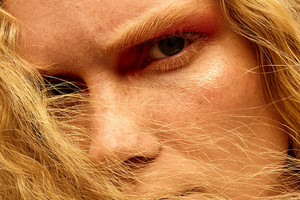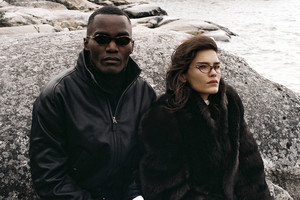Nadège Vanhée - Cybulski and Flora Moscovici In Conversation
Written by Phillipe Azoury by Sandra MyhrbergEver wondered what goes on behind the scenes when creative masterminds collaborate? Now is your chance to be a fly on the wall. Odalisque Magazine invites you to takepart in a conversation between Hermès Creative Director Nadège Vanhee-Cybulski and Artist Flora Moscovici on their artistic process for the Hermès S/S 2022 show which took place at Le Bourget Airport in October last year
Nadège, why did you approach Flora Moscovici to produce this work for the 2022 spring-summer collection?
N: I was aware of Flora's Work, I had seen it but I really encountered her painting with her installation at rue deValois, a magnificent work covering the scaffolding during renovations at the Ministry Of Culture.All of a sudden, the street was lit up. Herwayof usingcolour to transform public spaces in Paris meshed perfectly with the thought processes my teams and I had been engaged in since the pandemic, our aim being to renew the fashion show experience. Choosing Flora Was an obvious choice: I needed something light-filled,solar, an intensely physical approach to painting
Had You already decided to have the show at Le Bourget when you started working together?
N:Le Bourgetwas always our priority. We wanted a space at once monumental and open-ended.
Flora, working in situ, with foreknowledge of the places where you intend to pose and expose, is your method…
F:Location is often the starting-off point of my work. Contextis always key. I take over a space. At the beginning of the spring when Nadège and I began to talk about the show, the space had yet to be decided upon. But Iwas able to participate in the visits of prospective spaces; I was also privy to the early plans for scenography. This was of utmost importance since it allowed me to plan and project. I began imagining these large paintings, the Panoramas (around six meters high and nine meters wide). There are twelve now, as well as five that are seven meters wide. The initial twelve are hung in a circular manner and move forward, sliding and overlapping. In layers. The others also move, but in different directions.
In a 2016 exhibition, La Traversante, that was held in Paris at the Triple V Galerie, rue Louise Weiss, you painted the ceiling. Will you be doing that at Le Bourget, too?
F:No, this time the ceiling’s purposes will be purely technical. On the other hand, I found I could use Le Bourget’s concrete floor to connect through colour my paintings to architecture. The bleachers were also thought out as an extension of the concrete floor. The Paintings are freestanding; there are no walls. Simply The space itself appearing between the panoramas.
N:There are two spaces: the airport terminal as it is, plus an imaginary space instigated by the collection. Flora is used to working in pre-existing spaces that she embraces and makes her own. Her approach to colour and light creates a new ecosystem that ends up transforming a space. Here however another important element was in play: the colours of the collection. Flora's Work reinterprets those colours while transforming the Le Bourget airport terminal. It’s a dual challenge.
Did working with Nadège modify your creative process?
F:Yes, in terms of materials. This project is in the continuity of my approach to various spaces; here the fact that my starting point was the collection’s colours and how the collection inspired my imagination added a twist to the notion of context which is essential to my work. Though the range of colours that Nadège used was a point of departure to create the colour chart for my paintings, the materials were what interested me most. I tried to pictorially reproduce certain aspects of the collection’s fabrics:the iridescence of a certain cloth, or on the contrary its glossy or satin aspect. Here and there, I added light by using fluorescent or metallic paint (the latter in small doses). I do a lot of colour mixing. On This project Iworked with the material, the different textures in mind. Since I had twelve panorama lowland softly sliding one upon the other, I Was Able to work on transitions. Though the work is about the collection, there are also architectural echoes, and then we head toward landscapes, skies, the opening up that signals the end of the show. At that very point the collection and the space meet in my work.
Do You paint with a spray gun?
F:Yes, a spray gun like they use on work sites. I like to use it as one would a brush, overlapping tones. Each painting has around twenty colours mixed in.
N:I love the fact that Flora uses a totally industrial tool to head somewhere else. It’s always great to transform a tool. It fills me with optimism that one can always turn the trivial into the ethereal.
How was it to work together? What kind of dialogue did you have?
N:More than a dialogue, we both moved forward like two creative people used to working in a very solitary manner, concentrated on the tasks at hand,using few words, preferring the “language of silence.” Flora is a visionary who turns everything she touches into something both luminous and weight-less. Though deeply anchored in the earth, she always manages to find the highest point of elevation. Had we talked too much we might have disrupted the momentum without which her work can not thrive. Also: she instinctively understands the Hermès approach, the work of the hand, the importance of craft. She also has an intensely precise approach to gesture. When we spoke of colour and material, we both understood what feminine outline we were designing: a sun-kissed woman open to the world. We discussed the meaning of yellow at length: the colour of wheat, yes, but also in Antiquity It Was the maternal colour, the colour of women. The First few times Flora and I got together she had a book with her by Georges Didi-Huberman, The Man Who Walked in Colour – the title of which I was immediately taken with.
What will now become of the paintings?
N: For Flora and for us, they exist as works of art in their own right. We are currently thinking of the best way to preserve and show them, elsewhere, at a later date.
F:It’s both a set design and a work of art. I love that double status and it is something that came up at the very beginning of our exchanges. Nad ge was very receptive to the fact that what we were dealing with first and foremost was an artistic act.
N:I like the idea of the porous border between fashion and art.
N:No, it will be broadcast live worldwide and will also be rebroadcast on giant screens in several cities with their own scenographies (in Busan, South Korea, Kanagawa, Japan, NewYork, London, and Abu Dhabi), in places that bespeak openness, with clear horizons and waterfronts. The idea was to duplicate the experience elsewhere, on the same scale. It’s important, forin Flora's Work scope is paramount. It’s also a luxury– all the more precious after almost two years of being locked down.Today We must strive to recapture that horizon
About the Neuendorf house - a wet dream for architects since 1989 Hidden away in an olive grove near the village of Santanyi, the Neuendorf house was created in the late 80s by the architects John Pawson and Claudio Silvestrin. The house is the first and only created the world-renowned architects as a duo, considered among architecture aficionados to be among the top minimalist holiday homes ever built with its lean, geometric composition and muted pink hues complementing the dry, reddish terrain of southern Mallorca. Since then, they have both established hugely successful studios designer flagship stores for Giorgio Armani and Calvin Klein(Silvestri), Jil Sander and Christopher Kane (Pawson) among many other high-profile projects for museums, restaurants and private clients like KanyeWest (Silvestri)













